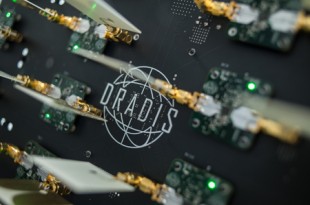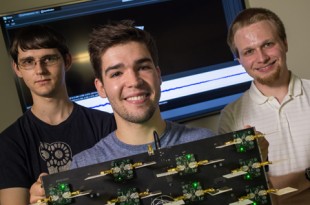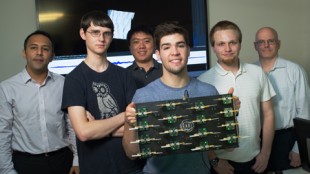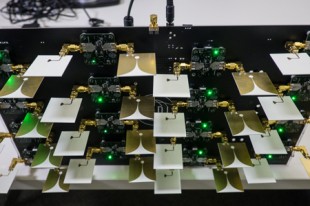David Ruth
713-348-6327
david@rice.edu
Jade Boyd
713-348-6778
jadeboyd@rice.edu
Rice engineering students create real-time 3-D radar system
Team D.R.A.D.I.S. designs concept for collision-avoidance system
HOUSTON — (May 4, 2005) — A real-time 3-D radar system designed by Rice University engineering students as a concept for a next-generation collision-avoidance system for the auto industry captured the $5,000 top prize at Rice’s annual Engineering Design Showcase and could have wider applications in security screening and biomedical imaging.
The trio of students, known as Team D.R.A.D.I.S (dynamic radar and digital imaging system), became the first team in Rice history to win two of the annual showcase’s top three honors — the first-place Excellence in Engineering Award as well as a $3,000 innovation award.
“In terms of potential applications, the real-time image processing that the team has demonstrated could be used for security screening, for the automotive industry and for medical applications,” said Aydin Babakhani, an assistant professor of electrical and computer engineering at Rice who sponsored the team. “With security, for example, the full-body scanners that are already used for airport screening are very expensive and huge. If D.R.A.D.I.S.’ technology were fully developed, it could provide a similar type of screening at a fraction of the cost, and it would be far more compact.”

D.R.A.D.I.S., an impulse-based radar system for real-time 3-D imaging, won two of the top three prizes at Rice University's annual Engineering Design Showcase. Credit: Jeff Fitlow/Rice University
Current radar systems in cars sense when objects are near, but they do not attempt to image them. D.R.A.D.I.S. does. Its 16 pulse-radar antennae feed data to a high-end gaming graphics card that uses more than 2,000 processing cores to complete about a trillion calculations per second.
D.R.A.D.I.S.’ “pulse radar” technology is different. It uses short bursts of low-power microwaves at a frequency around 10 gigahertz. The power level is about 10 million times less than a cellphone, which means the pulses travel only a short distance. But because they are pulses, they have a very large bandwidth and can capture a great deal of information about the target.
To build their antenna array, Rice engineering students Spencer Kent, Jeremy Hunt and Galen Schmidt purchased 16 off-the-shelf pulse-radar transceiver chips from startup XeThru, a reprogrammable piece of hardware called a “field programmable gate array” (FPGA) and an ARM processor like the ones used in smartphones. Almost everything else in D.R.A.D.I.S. was custom-built, including the 16 circuit boards for each transceiver and the backplane circuit board, which allows the transceivers to communicate with the FPGA and remain synchronized to within three-trillionths of a second. The team also wrote more than 10,000 lines of computer code.

D.R.A.D.I.S. team members (from left) Galen Schmidt, Spencer Kent and Jeremy Hunt. Credit: Jeff Fitlow/Rice University
Babakhani said Team D.R.A.D.I.S.’ attempt to incorporate off-the-shelf, low-power radar transceivers into a real-time 3-D imaging system is a first.
“They have not yet shown it is generating 3-D images, but they are still working and hope to finish before commencement,” Babakhani said. “If they do, we believe this will be the world’s first impulse-based, real-time 3-D imaging system.”
He said D.R.A.D.I.S. is important as a proof of concept because it shows what also might be accomplished using research-grade transceivers that work at more exotic wavelengths, such as the terahertz range.
D.R.A.D.I.S.’ faculty mentor Gary Woods, professor in the practice of electrical and computer engineering, said Schmidt, Hunt and Kent “performed at or above the level I have seen from seasoned, practicing engineers.”

Rice University's Team D.R.A.D.I.S. with faculty sponsor Aydin Babakhani (left), graduate student Peiyu Chen (third from left) and faculty mentor Gary Woods (right). Credit: Jeff Fitlow/Rice University
The trio, who are slated to graduate May 16 with degrees in electrical engineering, set a “very aggressive” schedule that called for custom designs or implementations of antennas, printed circuit boards, low-level software and high-level image reconstruction algorithms, Woods said.
The team said the prior research of graduate student Peiyu Chen, a member of Babakhani’s research group, was helpful in the early stages of the design phase last fall. Chen had already published research about image processing with a single transceiver setup that had similarities to the multi-antenna device the team envisioned.
“We weren’t sure, at that point, which type of radar we were going to use, but we thought we should at least be familiar with what he had done,” Schmidt said. “He had existing code that he was using to generate images off of the data that he was using from his project, so we looked at that code, determined how it worked and began thinking about how we could scale that up and improve it for our system.”

D.R.A.D.I.S. uses a multi-input, multi-output array of 16 transceivers based on chipsets from startup XeThru. Credit: Jeff Fitlow/Rice University
Prior to the showcase, the team spent well over 500 hours writing computer code for D.R.A.D.I.S. For starters, Hunt compiled a custom version of Embedded Linux for the system. Image processing was done on an NVIDIA graphics card, which boasts four teraflops of capacity and a whopping 2,048 processor cores. Schmidt also wrote the image processing code using an NVIDIA processing library called CUDA. In addition, the team had to create its own software for the graphical user interface as well as software to reconfigure the FPGA controller.
Though D.R.A.D.I.S.’ designers are graduating, the system will live on in Babakhani’s lab. Chen and other members of the research group are working with the trio to transfer all the software and hardware so they can adapt the setup to work with various chipsets they are researching in the lab.
“We’re all hoping it gets used in the future,” Hunt said. “From the beginning, our goal was to build D.R.A.D.I.S. in such a way that it’s modular, with the idea that Dr. Babakhani and his students could pop in a different chipset and build upon what we’ve done.”
-30-
VIDEO is available at:
http://youtu.be/QzXmBj0UBLU
High-resolution IMAGES are available for download at:
https://news2.rice.edu/files/2015/05/0504_DRADIS-logo-lg.jpg
CAPTION: D.R.A.D.I.S., an impulse-based radar system for real-time 3-D imaging, won two of the top three prizes at Rice University’s annual Engineering Design Showcase.
CREDIT: Jeff Fitlow/Rice University
https://news2.rice.edu/files/2015/05/0504_DRADIS-team-lg.jpg
CAPTION: D.R.A.D.I.S. team members (from left) Galen Schmidt, Spencer Kent and Jeremy Hunt.
CREDIT: Jeff Fitlow/Rice University
https://news2.rice.edu/files/2015/05/0504_DRADIS-six-lg.jpg
CAPTION: Rice University’s Team D.R.A.D.I.S. with faculty sponsor Aydin Babakhani (left), graduate student Peiyu Chen (third from left) and faculty mentor Gary Woods (right).
CREDIT: Jeff Fitlow/Rice University
https://news2.rice.edu/files/2015/05/0504_DRADIS-trans-lg.jpg
CAPTION: D.R.A.D.I.S. uses a multi-input, multi-output array of 16 transceivers based on chipsets from startup XeThru.
CREDIT: Jeff Fitlow/Rice University
For more information about D.R.A.D.I.S., visit:
http://oedk.rice.edu/Sys/PublicProfile/25617124/3637470
Located on a 300-acre forested campus in Houston, Rice University is consistently ranked among the nation’s top 20 universities by U.S. News & World Report. Rice has highly respected schools of Architecture, Business, Continuing Studies, Engineering, Humanities, Music, Natural Sciences and Social Sciences and is home to the Baker Institute for Public Policy. With 3,888 undergraduates and 2,610 graduate students, Rice’s undergraduate student-to-faculty ratio is just over 6-to-1. Its residential college system builds close-knit communities and lifelong friendships, just one reason why Rice is highly ranked for best quality of life by the Princeton Review and for best value among private universities by Kiplinger’s Personal Finance. To read “What they’re saying about Rice,” go here.

